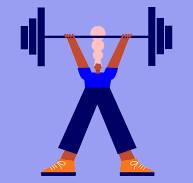The Benefits of Incorporating Track Workouts Into Your Fitness Routine
Track workouts are a fantastic way to boost your fitness level, whether you’re a seasoned athlete or just starting your fitness journey. Running on a track offers numerous benefits that can help improve your overall health and performance. Here are some key advantages of incorporating track workouts into your routine:
Improved Speed and Endurance
Running on a track allows you to measure your distance accurately and monitor your progress over time. By incorporating interval training and speed work into your routine, you can improve your speed and endurance significantly. Sprinting short distances followed by recovery periods can help increase your cardiovascular fitness and build muscle strength.
Enhanced Mental Toughness
Track workouts often involve pushing yourself outside of your comfort zone, which can help build mental toughness and resilience. Overcoming challenges like fatigue and pushing through tough intervals can boost your confidence and mental strength, not just in running but in other areas of life as well.
Variety in Training
Running on a track offers a change of scenery from traditional road running or treadmill workouts. The flat, consistent surface of the track allows for precise training sessions that target specific aspects of your fitness, such as speed, endurance, and form. Mixing up your training with track workouts can prevent boredom and keep you motivated to reach new goals.
Community Support
Many tracks are open to the public or part of community centers where you can connect with other runners and receive support from fellow athletes. Joining a local track club or group workout session can provide motivation, accountability, and camaraderie as you work towards your fitness goals together.
Injury Prevention
The consistent surface of a track can be gentler on your joints compared to uneven terrain or hard pavement. Running on a track may reduce the risk of injuries caused by repetitive stress or impact on hard surfaces. Additionally, proper warm-up routines and cool-down stretches before and after track workouts can help prevent injuries and improve flexibility.
If you’re looking to take your fitness to the next level, consider adding track workouts to your routine. Whether you’re aiming to improve your speed, endurance, mental toughness, or overall health, running on a track can be an effective way to achieve your fitness goals.
Top 7 Frequently Asked Questions About Track and Field
- What is a track?
- How long is a standard track?
- What are the different types of track events?
- How do you train for track and field?
- What are the benefits of running on a track?
- Are there specific shoes for track running?
- How can I improve my speed on the track?
What is a track?
A track is a designated path or course, typically marked with lanes and distance markers, used for various activities such as running, walking, cycling, or racing. Tracks are commonly found in athletic facilities, schools, parks, and recreational areas. They provide a controlled environment for individuals to engage in physical exercise or competitive sports. The surface of a track is usually made of materials like rubber, asphalt, or synthetic turf to offer a consistent and durable running surface. Tracks are designed to accommodate different types of workouts and training sessions to help individuals improve their speed, endurance, and overall fitness levels.
How long is a standard track?
A standard track, often used for competitive running and training purposes, typically measures 400 meters in length. This distance allows for standardization in track events and facilitates accurate timing and distance measurements. The oval shape of the track consists of two straight sections and two curved sections, with each straightaway measuring 100 meters and each curve designed to maintain the total distance of 400 meters. Understanding the dimensions of a standard track is essential for athletes, coaches, and spectators to ensure fair competition and precise performance evaluation in various track and field events.
What are the different types of track events?
Track events encompass a wide range of disciplines that cater to various athletes with different strengths and skill sets. Some of the different types of track events include sprints, middle-distance races, long-distance races, hurdles, relays, and field events such as the long jump, high jump, pole vault, and throwing events like shot put, discus throw, and javelin throw. Each track event requires specific techniques, strategies, and training regimens to excel in that particular discipline. Whether you prefer the explosive speed of sprints or the endurance challenge of long-distance races, there is a track event suited for every athlete looking to test their limits and showcase their athletic abilities on the track.
How do you train for track and field?
Training for track and field requires a combination of physical conditioning, technique work, and mental preparation. Athletes typically engage in a variety of training activities tailored to their specific events, such as sprinting, distance running, jumping, throwing, or hurdling. A well-rounded training program often includes speed workouts, strength training, plyometrics, flexibility exercises, and drills to improve form and technique. It is essential for track and field athletes to work closely with coaches to develop personalized training plans that address their strengths and areas for improvement. Consistent practice, dedication, and a positive mindset are key components of successful track and field training.
What are the benefits of running on a track?
Running on a track offers a multitude of benefits for individuals looking to enhance their fitness level and overall well-being. One key advantage of running on a track is the ability to accurately measure distances and monitor progress, making it easier to track improvements in speed and endurance over time. Additionally, incorporating interval training and speed work on a track can help boost cardiovascular fitness, build muscle strength, and improve overall performance. The flat, consistent surface of the track provides a safe environment for running that can be gentler on joints compared to uneven terrain or hard pavement, potentially reducing the risk of injuries. Furthermore, engaging in track workouts can help increase mental toughness, provide variety in training routines, foster community support through group workouts, and contribute to injury prevention through proper warm-up and cool-down practices.
Are there specific shoes for track running?
When it comes to track running, having the right footwear is crucial for performance and injury prevention. Specific shoes designed for track running offer features tailored to the demands of the sport. Track running shoes are lightweight, flexible, and provide traction on the track surface to enhance speed and agility. They often have spikes or cleats that can be customized based on the type of track and distance you’re running. These specialized shoes offer support and stability while promoting proper foot mechanics during sprints, intervals, or long-distance runs on the track. Choosing the appropriate track shoes can make a significant difference in your comfort, performance, and overall running experience.
How can I improve my speed on the track?
To improve your speed on the track, incorporating specific training techniques can be highly beneficial. Interval training, which involves alternating between high-intensity sprints and recovery periods, is a great way to boost your speed and endurance. Focusing on proper running form and technique can also make a significant difference in your speed performance. Additionally, strength training exercises that target leg muscles can help improve your power and explosiveness during sprints. Consistent practice, dedication, and setting realistic goals are key factors in enhancing your speed on the track over time.




